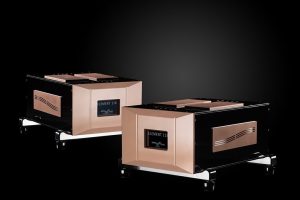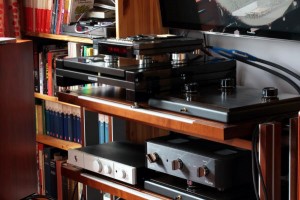One of those wall-warts came with the Fidelizer EtherStream network switch I use for music streaming. These little switch-mode devices have known issues. It is not good for music streaming; even worse, it spews contagion throughout the electric grid. With the ethernet switch on, my primary sources were degraded: the CD transport sounded worse. I tried moving the streaming gear off the dedicated AC line to a regular household one and I plugged it into its own passive power distributor (a Nordost QBASE8). Although these efforts helped, there was no escaping the obvious: the thing to do was toss it. Toss them all, if you have more than one.
The Sbooster LPS
So began my adventures with linear power supplies—small, external boxes with an AC to DC transformer that can replace the wall-wart. I quickly got in the Sbooster LPS (MSRP $399), which my editor recommended for the best price/performance ratio at the low-end. Although quite a step up for streaming, the Sbooster's warm and bloomy signature proved too much for my taste.
The Nikola Signature LPS
A year later, Fidelizer sent over their Nikola Signature LPS (MSRP $695). Was it better than the Sbooster? The Nikola Sig was linear, resolving, and musical beyond the Sbooster. It was like upgrading music streaming from low to mid-fi—but if you aspire to the Hi-end there was still a hill to climb.
The QSOURCE and Ethernet Streaming
Clearly, I had to take a leap up, and so the next move was to the Nordost QSOURCE ($2749). There wasn't much discussion about it on the internet; all the reviews had it paired with the QPOINT product and mostly talked about the QPOINT, so I didn't really have any expectations. I would find out for myself.
I gave it the recommended 7-10 days of burn-in, then started up Roon and went right to the second movement Adagio of the Dvořák Violin Concerto, with Augustin Hadelich as soloist and Jakub Hrůša conducting the Symphonieorchester des Bayerischen Rundfunks (Bohemian Tales, Warner Classics 527476, streamed from Qobuz). This is my go-to title for reference-level streaming at the moment. Both performance and sound are simply splendid, surely worthy of qualifying as a Super Disc.
Soundstage and Atmosphere
The move to the QSOURCE did not shake up the grand scheme of things, as the Nikola had already laid the groundwork. (Going from the Sbooster to the Nikola—that was dramatic.) How do you put a dollar figure on atmosphere, low-level resolution, and timbral finesse? The QSOURCE pumped in air, enlarging each image particularly in the width. In a similar manner, large groups, such as the many string players, grew wider. And once more, as the orchestral corps in toto filled out to assume most of the acreage side-to-side between the speakers.
Everything became less rigid. Tension eased and image outlines acquired soft shoulders. In the same way as the atmosphere expanded, the easing of tension scaled from the individual image, to groups, to the entire presentation. The upshot was less resemblance to the hard-edged, stand-up cutouts of a board game, and less emptiness at the interstices between the images.
Low-Frequency Orchestral Maneuvers
Usually, when you increase air and loosen the grip, vagueness and blur are introduced. In this case it was the opposite. The QSOURCE drew the soundstage map with exacting precision, opening up blocked areas and extending the view deep into the corners. From the listening seat you gazed upon soft, large images containing oodles of detail around and within them. For example, the low-frequency instruments—cellos, double bass, low brass, and percussion—contain information describing the recording venue. The cues for hall echo and instrument decay had been ill-defined, but not anymore. Meanwhile, the treble acquired flesh and integrated better with the midrange.
Timbral Finesse
The QSOURCE coupled deep resolution, transparency, and relaxation, forging a potent amalgam. When focusing on the solo instrument, sure Hadelich's breathing is audible, but put that aside. Instead, hone in on the abundant detail, timbral color, and supple dynamics that bring an altogether newfound lyricism.
Cosmetics
"Nice bodies," that's how you could describe the brushed silver and matte black accents of the Nordost family of QRT accessories. Like the QBASE and the QKORE, the QSOURCE chassis is well-constructed of high-quality parts, resonance tuned, and made from billet aluminum. Unlike them, it contains a QRT module that subtly alters the sound. The LPS uses a transformer that operates at an extremely low noise level and barely gets warm, so it can run without a fan.
The QSOURCE, the Sbooster, and the Nikola share compact dimensions and weight, but don't look anything alike. Long and narrow, weighing 6lbs, I didn't think the QSOURCE stable enough to fiddle with footers. (Nordost sells an adaptor if you want to use Sort Kones under it.)
Installation
The installation consisted of an Audience frontRow High Power PC from the wall to a QBASE8 power distributor. An Audioquest Dragon Source PC went to the QSOURCE (the Nikola LPS used these same power cords and QBASE8). The QSOURCE was connected to a QKORE Ground Unit. And, finally, I set the QSOURCE to 12 volts and connected to the EtherStream network switch. (A pair of slider switches make it easy to change output voltage. Another nice touch is an On/Off switch, which made for less wear and tear on the power cord inlet.)
Premium QSOURCE DC Cable
The umbilical between the QSOURCE and the device it is powering is a specialized DC cable (sold separately). You specify the output connector to match your gear when ordering. Just as they discovered with the QKORE product, the quality of these wires makes a difference, and Nordost recently released a Premium QSOURCE DC Cable. Here's a description from the manufacturer:
Nordost's Premium DC cable uses 2 x 18 AWG, silver-plated, solid core OFC conductors, which have been arranged in a twisted pair construction. This geometry helps to eliminate noise within the cable. However, to further safeguard from RFI and EMI, the conductors are protected by a braided shield. Additionally, the Premium QSOURCE DC Cable uses Nordost's Micro Mono-Filament technology in order to increase signal speeds by introducing an air-dielectric to the cable design.
Original QSOURCE DC Cable
The original QSOURCE DC Cable differs in these respects: the gauge is 2 x 22 AWG and the outer covering is black (the premium is light blue). The original is physically much thinner and slightly more flexible (although neither presents a problem to work with). Burn-in is around 2 weeks for the DC cables.
Swapping DC cables
I compared the original and premium DC cables using the EtherStream switch and was a bit surprised to find the premium almost mimicked the qualities of the QSOURCE itself, imparting smoother dynamic transitions, spaciousness, more complex timbres, plus a little boost in bass power. One cannot doubt the importance of power umbilical's.
Variable voltage switches on bottom
Multiple Outputs on the LPS
Multitasking in audio—as in life—often proves a poor choice. Many LPS models can be adapted to drive multiple devices, but this very often results in a watered-down version of the single device performance. When I ordered the fittings to attach a second device to my CH Precision X1 External Power Supply, it was not as good as when only one CH device was attached. When I listened to the Fidelizer Nikola powering two devices, then turned one off, the sound improved. With these two power supplies, a single connected device was the way to go.
The QSOURCE has six outputs, four of which are dedicated to the Nordost QPOINT product (sold separately). The remaining two can be adjusted to variable output voltages and are suitable to replace the wall-warts used by many music servers, NAS drives, etc. I powered up the QSOURCE with two devices attached, then switched one off, with the expectation that it would follow the pattern and show an improvement—but it didn't. The QSOURCE is the exception to the multitasking rule.
Conclusion
For the audio consumer, the laws of price and performance are writ in stone. You get what you pay for. Certainly that applies to the three linear power supplies that I auditioned over the last year or two.
Beyond any doubt, eliminating the wall-wart that came with the ethernet network switch is major. The entry-level Sbooster at $399 got me started. For a couple of hundred more, you might consider the Fidelizer Nikola Signature at $695, an all-around respectable device that will move performance up to mid-fi level. The improvement is sizable; the Nikola Signature is a good value.
However, if your destination is the Hi-End, there's still a hill to climb. To introduce intangibles like atmosphere and timbral finesse, along with tangibles like deep resolution and transparency out to the corners, you might consider the Nordost QSOURCE. It's at a different price point, but I don't think you'll be able to get the top-tier performance it delivered for less. Frankly, the level of refinement the QSOURCE LPS brought exceeded my expectations; my quest for a Hi-End LPS ends here.
QSOURCE Linear Power Supply
Retail: $2749
QSOURCE DC Cable
Retail: $299.99/m
Premium QSOURCE DC Cable
Retail: $339.99/m
Nordost






















































